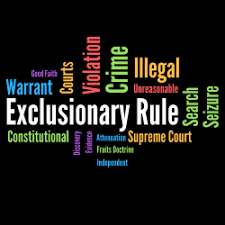
The Exclusionary Rule
Order Instructions:
Research and read the article by Donald Dripps entitled “The Case for the Contingent Exclusionary Rule,” from the American Criminal Law Review (Winter, 2001).
•Based on the article and your current level of exposure to the topic of constitutional criminal procedure, outline your position as to how Dripps’ model would work in the real world.
State whether Dripps’ Model of “Contingent Suppression” is in any way compatible with restorative justice. If not, how could it be made more compatible?
•Provide at least 1 reference
SAMPLE ANSWER
The Exclusionary Rule
With the exclusionary rule in place, problems such as those of political interference of the court system will be resolved given that the highest court has the power to impose any rule that is encrypted in the constitution. The problem of valuation will also be long gone with the exclusion rule in place because it balances the sanctions and the illegal gains of the government. Despite, these benefits, this rule have certain weakness given that it poses a crucial psychological challenge to the judgement. It is not a very easy for the judges to set free a suspect whom they are aware is guilty as charged. In an attempt to deal with this challenge, judges who are on trial are forced to change their truth seeking attention against the tenets of exclusion (Clancy, 2013). On the other hand other judges in the court chambers are forced to interpret the laws on constitutional rights contrary to that of the trial judges. Therefore, it for a fact that amendment on exclusion law remains inadequately implemented.
In his article about contingent exclusionary rule, Donald Drips suggests a model that can be used in the implementation of the exclusionary rule. He says that it is possible to bring together damages and exclusion in order to do develop a much more effective nd sustainable solution to all violations of the constitution. He further adds that courts can be allowed to suppress some of those orders that are considered uncertain in nature probably because of failure of the police force to do is job well (Dripps, 2010). However, friendly as this offer may seem to be, it not so compatible with the theory of restorative justice. As much as the cases are suppressed by the judges, it would be necessary to keep the suspected criminals on probation to take care of the interests of the crime victims rather than allowing the suspect to freely get back to the community and prematurely interact with victims of crime. This way, restorative justice shall have been achieved.
References
Donald A. Dripps (2010), The ‘New’ Exclusionary Rule Debate: From’Still Preoccupied with 1985’ to ’VirtualDeterrence’, Fordham Urban Law Journal, Vol. 37, Issue 3 (May 2010), pp. 743-802. http://www.heinonline.org/HOL/Page?handle=hein.journals/frdurb37&div=31
Thomas K. Clancy (2013), ‘The ExclusionaryRule: Is It On Its Way Out? Should It Be?’: Guest Editor: Christopher Slobogin: The Fourth Amendment’s ExclusionaryRule as a Constitutional Right. The Ohio State Journal of Criminal Law, 2013/04/01, Vol: 10, p357
We can write this or a similar paper for you! Simply fill the order form!




